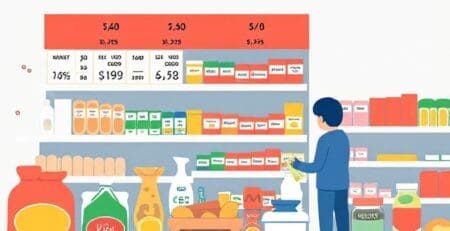Purchasing power, inequality, and the sustainability of living in Albania (2023–2025)
The analysis for the period 2023–2025, based on INSTAT data and studied by ALTAX’s simulated economic development scenarios, provides a clear picture of the internal tensions shaping Albanian household economics. At first glance, incomes and expenditures appear in a stable balance, but behind this nominal stability lies a fragile social dynamic—strongly influenced by inflation, regional inequalities, and the lack of diversified income sources.
1. The fragile balance between income and the cost of living
Average monthly household spending in Albania increased by about 1.5% between 2023 and 2024, while average inflation stood at 2.4%. This means that, in real terms, purchasing power declined by roughly 1%.
Within this context, Albanian households continue to operate under financial survival mode, with 55–60% of their budgets spent on food, energy, and housing. Savings remain minimal, often replaced by informal income, remittances, or pension support.
In urban areas, particularly Tirana and Durrës household budgets face greater pressure due to high housing and service costs, while rural families, though facing lower prices, suffer from lack of formal employment and limited market access.
2. Wage growth and the effects of inflation
Nominal wages increased on average by 2.6% to 11.7% during 2024–2025, reflecting both market dynamics and policy efforts to preserve purchasing power. However, the analysis shows that every 5% increase in inflation absorbs nearly half of the real gains from wage growth.
In a scenario with 10% inflation, the real purchasing power of wages rises by only 1.5%, indicating that Albanian workers experience limited real improvement in living standards despite nominal increases.
This reality highlights the structural dependency of households on dual income sources to meet basic needs, increasing pressure on female employment and informal work participation. Without meaningful inflation control, wage growth alone maintains an “illusion of stability,” where economic progress is more perceived than real.
3. Pensions as a secondary stabilizing mechanism
Pensions play a crucial role in household consumption stability. In 2024, the average pension of 19,800 ALL contributed over 21% to the typical family budget. The combination of one net salary (60,000 ALL) and one average pension raises household coverage from 65% to over 87% of essential needs.
Under the ALTAX gradual reform scenario, the average pension is projected to reach 40,000 ALL by the end of 2029, through:
– Annual progressive indexation of 5–6%,
– Improvement of the wage-to-pension ratio to 60%,
– Expansion of the contributory base.
This scenario would ensure full coverage of essential household needs for a family with one employed person and one retiree, increasing basic consumption, reducing elderly poverty, and contributing to sustained aggregate demand growth.
At the macro level, this would result in:
– Plus 1.2% GDP growth by 2029,
– A drop in elderly poverty from 31% to 18%,
– Higher basic consumption and improved intergenerational equity.
4. Regional inequalities: a two-speed development pattern
Household spending in 2024 shows sharp contrasts:
- Tirana: 108,588 ALL/month → 16.7% above national average.
- Kukës: 75,048 ALL → 19.4% below average.
Three regional blocks stand out:
– Tirana, Durrës, Korça with high consumption, higher formality, multiple income sources;
– Fier, Shkodër, Vlorë with moderate consumption sustained by remittances and tourism;
– Kukës, Dibër, Elbasan, Berat with low consumption, high dependency on pensions and social aid.
The ratio between the richest and poorest regions remains 1.45/1, unchanged since 2023. These inequalities are structural, linked to uneven urbanization, migration trends, and disproportionate public investment distribution.
5. Sensitivity to food and energy inflation
Price increases in food and energy remain the most threatening factors for household budgets.
A 10% rise in these categories reduces the affordability of the average wage from 65% to 61.5% of monthly needs.
Under a +20% price increase scenario, affordability drops below 59%, forcing families to cut essential consumption and rely more heavily on aid or remittances.
This calls for active protective policies:
– Targeted energy subsidies,
– Compensation for essential goods,
– Automatic indexation of economic assistance according to food inflation.
6. The 2025–2029 outlook, toward sustainable affordability
If the ALTAX pension increase scenario to 40,000 ALL combines with inflation control and labor formalization, Albania could reach a new social equilibrium by the end of the decade, where:
– Real purchasing power increases by 6–7 points,
– Regional inequality gradually declines,
– Basic consumption becomes more stable,
– Fiscal policy gains a stabilizing, not merely reactive, role.
However, this scenario requires fiscal discipline, a broader tax base, and investment reorientation toward poorer regions. Without these measures, Albanian household economics will remain nominally stable but structurally fragile.
The household economy at the dawn of a new social cycle
Albania stands at a point where macroeconomic stability has not yet translated into sustainable social well-being.
Wages and pensions are rising, but inflation, living costs, and inequality continue to neutralize their effects.
To preserve the economic dignity of families, a new policy balance is needed between real wages, affordable pensions, and active social assistance, not as survival transfers but as instruments of inclusive development. Through this integrated approach, Albania’s economy can move from nominal stability to real sustainability, building a livelihood model that reflects citizens’ needs and ensures equitable territorial development.



Leave a Reply
You must be logged in to post a comment.